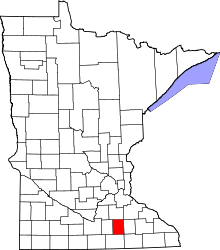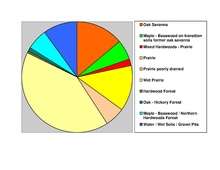Steele County, Minnesota
| Steele County, Minnesota | |
|---|---|
 Steele County Courthouse in Owatonna | |
 Location in the U.S. state of Minnesota | |
 Minnesota's location in the U.S. | |
| Founded | February 20, 1855[1] |
| Named for | Franklin Steele |
| Seat | Owatonna |
| Largest city | Owatonna |
| Area | |
| • Total | 432 sq mi (1,119 km2) |
| • Land | 430 sq mi (1,114 km2) |
| • Water | 2.7 sq mi (7 km2), 0.6% |
| Population (est.) | |
| • (2015) | 36,755 |
| • Density | 85/sq mi (33/km²) |
| Congressional district | 1st |
| Time zone | Central: UTC-6/-5 |
| Website |
www |
Steele County is a county located in the U.S. state of Minnesota. As of the 2010 census, the population was 36,576.[2] Its county seat is Owatonna.[3] The county was named for Franklin Steele, a prominent early resident of the state.[4]
Steele County comprises the Owatonna, MN Micropolitan Statistical Area.
Geography
According to the U.S. Census Bureau, the county has a total area of 432 square miles (1,120 km2), of which 430 square miles (1,100 km2) is land and 2.7 square miles (7.0 km2) (0.6%) is water.[5]

The Straight River flows northwardly through the county, and the Le Sueur River flows through its southwestern corner. The Middle Fork of the Zumbro River has its headwaters in the northeastern part of the county.[7]
Lakes
- Beaver Lake: in Berlin Township
- Fosilen Lake: in Berlin Township
- Lake Kohlmeier: in Owatonna, Owatonna Township
- Lonergan Lake: in Berlin Township
- Oak Glen Lake: in Blooming Prairie Township
- Rice Lake: mostly in Havana Township, but the far eastern edge extends into Dodge County
- Rickert Lake: in Blooming Prairie Township
- Swan Lake: in Deerfield Township
Major highways
Adjacent counties
- Rice County (north)
- Dodge County (east)
- Mower County (southeast)
- Freeborn County (south)
- Waseca County (west)
Demographics
| Historical population | |||
|---|---|---|---|
| Census | Pop. | %± | |
| 1860 | 2,863 | — | |
| 1870 | 8,271 | 188.9% | |
| 1880 | 12,400 | 49.9% | |
| 1890 | 13,232 | 6.7% | |
| 1900 | 16,524 | 24.9% | |
| 1910 | 16,146 | −2.3% | |
| 1920 | 18,061 | 11.9% | |
| 1930 | 18,475 | 2.3% | |
| 1940 | 19,749 | 6.9% | |
| 1950 | 21,155 | 7.1% | |
| 1960 | 25,029 | 18.3% | |
| 1970 | 26,931 | 7.6% | |
| 1980 | 30,328 | 12.6% | |
| 1990 | 30,729 | 1.3% | |
| 2000 | 33,680 | 9.6% | |
| 2010 | 36,575 | 8.6% | |
| Est. 2015 | 36,755 | [8] | 0.5% |
| U.S. Decennial Census[9] 1790-1960[10] 1900-1990[11] 1990-2000[12] 2010-2015[2] | |||

As of the census of 2000,[13] there were 33,680 people, 12,846 households, and 9,082 families residing in the county. The population density was 78 people per square mile (30/km²). There were 13,306 housing units at an average density of 31 per square mile (12/km²). The racial makeup of the county was 95.19% White, 1.07% Black or African American, 0.10% Native American, 0.85% Asian, 0.02% Pacific Islander, 1.65% from other races, and 1.12% from two or more races. 3.76% of the population were Hispanic or Latino of any race. 38.6% were of German, 18.5% Norwegian, 5.2% Czech and 5.1% Irish ancestry.
There were 12,846 households out of which 35.50% had children under the age of 18 living with them, 59.50% were married couples living together, 7.40% had a female householder with no husband present, and 29.30% were non-families. 24.60% of all households were made up of individuals and 10.30% had someone living alone who was 65 years of age or older. The average household size was 2.57 and the average family size was 3.08.
In the county the population was spread out with 27.90% under the age of 18, 8.20% from 18 to 24, 29.00% from 25 to 44, 21.60% from 45 to 64, and 13.30% who were 65 years of age or older. The median age was 36 years. For every 100 females there were 97.50 males. For every 100 females age 18 and over, there were 95.00 males.
The median income for a household in the county was $46,106, and the median income for a family was $53,981. Males had a median income of $36,366 versus $25,054 for females. The per capita income for the county was $20,328. About 4.20% of families and 6.20% of the population were below the poverty line, including 7.10% of those under age 18 and 7.10% of those age 65 or over.
Communities
Cities
- Blooming Prairie (partly in Dodge County)
- Ellendale
- Medford
- Owatonna (county seat)
Townships
Unincorporated communities
- Bixby
- Clinton Falls
- Deerfield
- Havana
- Hope
- Lemond
- Litomysl
- Meriden
- Merton
- Moland
- Pratt
- Saco
- Steele Center
Ghost town
See also
- National Register of Historic Places listings in Steele County, Minnesota
- Steele County Historical Society
- City of Owatonna
- City of Medford
- City of Blooming Prairie
- City Of Ellendale
- Rice Lake State Park
References
- ↑ "Minnesota Place Names". Minnesota Historical Society. Retrieved March 19, 2014.
- 1 2 "State & County QuickFacts". United States Census Bureau. Retrieved September 1, 2013.
- ↑ "Find a County". National Association of Counties. Retrieved 2011-06-07.
- ↑ Upham, Warren (1920). Minnesota Geographic Names: Their Origin and Historic Significance. Minnesota Historical Society. p. 531.
- ↑ "2010 Census Gazetteer Files". United States Census Bureau. August 22, 2012. Retrieved October 25, 2014.
- ↑ Nelson, Steven (2011). Savanna Soils of Minnesota. Minnesota: Self. pp. 43 - 48. ISBN 978-0-615-50320-2.
- ↑ Minnesota Atlas & Gazetteer. Yarmouth, Me.: DeLorme. 1994. pp. 24, 33. ISBN 0-89933-222-6.
- ↑ "County Totals Dataset: Population, Population Change and Estimated Components of Population Change: April 1, 2010 to July 1, 2015". Retrieved July 2, 2016.
- ↑ "U.S. Decennial Census". United States Census Bureau. Retrieved October 25, 2014.
- ↑ "Historical Census Browser". University of Virginia Library. Retrieved October 25, 2014.
- ↑ "Population of Counties by Decennial Census: 1900 to 1990". United States Census Bureau. Retrieved October 25, 2014.
- ↑ "Census 2000 PHC-T-4. Ranking Tables for Counties: 1990 and 2000" (PDF). United States Census Bureau. Retrieved October 25, 2014.
- ↑ "American FactFinder". United States Census Bureau. Retrieved 2008-01-31.
External links
 |
Rice County |  | ||
| Waseca County | |
Dodge County | ||
| ||||
| | ||||
| Freeborn County | Mower County |
Coordinates: 44°01′N 93°13′W / 44.02°N 93.22°W